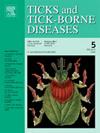Vaccinomics-driven selection and validation of protective salivary antigens from the argasid tick Ornithodoros moubata
IF 3.4
2区 医学
Q2 INFECTIOUS DISEASES
引用次数: 0
Abstract
Ornithodoros moubata serves as primary vector of African swine fever and tick-borne human relapsing fever in Africa. Developing an effective vaccine targeting this argasid tick would significantly enhance disease control measures. To identify potential vaccine targets, the recently characterised sialome of O. moubata was analysed using a vaccinomics approach. This led to the identification of a set of salivary secreted proteins predicted to be antigenic and implicated in the regulation of blood-feeding and host immune defences. The objective of this study was to evaluate the protective potential of seven of these proteins, namely Complement inhibitor (OmCI), Cyclophilin (OmCPH), Hypothetical protein 275 (OmH275), Peroxiredoxin (OmPXR), Calreticulin (OmCLR), Neprilysin (OmNEP), and Superoxide dismutase (OmSOD). These candidates were produced as recombinant proteins, formulated with Montanide adjuvant, and administered individually to different groups of rabbits. Adult and nymphal-3 specimens of O. moubata and Ornithodoros erraticus (the Mediterranean vector of ASF and TBRF) were allowed to feed on the vaccinated rabbits, and the ticks’ feeding performance, survival, and reproduction rates were assessed. OmH275, OmPXR, OmCPH, and OmCLR conferred 20 %–32 % protection against O. moubata and/or O. erraticus, whereas OmCI, OmNEP, and OmSOD afforded 2 %–17 % protection against one or both tick species. Consequently, OmH275, OmPXR, OmCPH, and OmCLR were deemed suitable candidates for inclusion in the development of anti-Ornithodoros cocktail vaccines, while OmCI, OmNEP, and OmSOD were considered less promising for tick vaccine development. These findings validate the vaccinomics pipeline, identifying four of seven candidates (57 %) as viable antigens for Ornithodoros tick vaccines.

疫苗组学驱动的moubata鸟蜱保护性唾液抗原的选择和验证
在非洲,摩巴塔鸟是非洲猪瘟和蜱传人类回归热的主要媒介。开发一种有效的针对这种蜱虫的疫苗将大大加强疾病控制措施。为了确定潜在的疫苗靶点,使用疫苗组学方法分析了最近表征的moubata唾液体。这导致了一组唾液分泌蛋白的鉴定,这些蛋白被预测为抗原性的,并涉及血液摄食和宿主免疫防御的调节。本研究的目的是评估补体抑制剂(OmCI)、亲环蛋白(OmCPH)、假设蛋白275 (OmH275)、过氧化物还氧蛋白(OmPXR)、钙网蛋白(OmCLR)、耐药蛋白(OmNEP)和超氧化物歧化酶(OmSOD) 7种蛋白质的保护潜力。这些候选物以重组蛋白的形式生产,与Montanide佐剂配制,并单独给予不同组的兔子。将非洲猪瘟和TBRF地中海病媒moubata O. moubata和Ornithodoros erraticus成虫和幼虫3号标本采食接种疫苗的家兔,评估其采食性能、存活率和繁殖率。OmH275、OmPXR、OmCPH和OmCLR对moubata和/或O. erraticus的保护率为20% - 32%,而OmCI、OmNEP和OmSOD对一种或两种蜱虫的保护率为2% - 17%。因此,OmH275、OmPXR、OmCPH和OmCLR被认为适合用于抗鸟蛾鸡尾酒疫苗的开发,而OmCI、OmNEP和OmSOD被认为不太有希望用于蜱虫疫苗的开发。这些发现证实了疫苗组学途径,确定了7个候选抗原中的4个(57%)作为鸟thodoros蜱疫苗的活抗原。
本文章由计算机程序翻译,如有差异,请以英文原文为准。
求助全文
约1分钟内获得全文
求助全文
来源期刊

Ticks and Tick-borne Diseases
INFECTIOUS DISEASES-MICROBIOLOGY
CiteScore
6.90
自引率
12.50%
发文量
185
审稿时长
6-12 weeks
期刊介绍:
Ticks and Tick-borne Diseases is an international, peer-reviewed scientific journal. It publishes original research papers, short communications, state-of-the-art mini-reviews, letters to the editor, clinical-case studies, announcements of pertinent international meetings, and editorials.
The journal covers a broad spectrum and brings together various disciplines, for example, zoology, microbiology, molecular biology, genetics, mathematical modelling, veterinary and human medicine. Multidisciplinary approaches and the use of conventional and novel methods/methodologies (in the field and in the laboratory) are crucial for deeper understanding of the natural processes and human behaviour/activities that result in human or animal diseases and in economic effects of ticks and tick-borne pathogens. Such understanding is essential for management of tick populations and tick-borne diseases in an effective and environmentally acceptable manner.
 求助内容:
求助内容: 应助结果提醒方式:
应助结果提醒方式:


